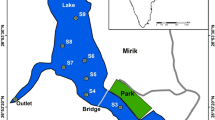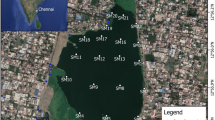Abstract
The mobile forms of heavy metals are the exchangeable phases of these metals that represent the bioavailable toxic hazards in the marine environment. The exchangeable forms of Fe, Zn, Cu, Mn, and Pb were measured using atomic absorption spectrophotometry in the inshore sediments at five locations along the Red Sea coast in areas under natural and anthropogenic discharges. The fine sediment group (FSG) reached the average of 51.29 % representing the controlling and vital factor in the different geochemical processes that occur in seabed sediments. Hamrawin Bay recorded the highest averages of Mn (283.55 μg/g), Zn (99.63 μg/g), and Pb (73.35 μg/g). Abu Dabab recorded the highest average of Fe (1336.41 μg/g), Shalateen exhibited the highest Cu average (35.62 μg/g) and the lowest averages of Mn, Zn, and Pb (50.18, 24.28, and 18.44 μg/g), and Qula’an showed the lowest averages of Fe and Cu (944.61 and 17.39 μg/g). The estimated results indicated that the exchanges from one phase to another were active in all locations due to the continuous reworking processes in the surface sediments. Under the oxic conditions, oxides, hydroxides, and carbonates of Fe, Mn, and Zn were expected to be the dominant metal forms associated with the sand fraction at the different locations. Under the reducing environments (anoxic conditions), sulfide forms of Fe, Pb, Mn, and Cu were associated with fine sediment fractions (very fine sand, silt, and mud) were dominant. Ionic exchanges were active in the near bottom and the interstitial water during the transformation operations from one phase to another at the different locations. The continuity of the forms transformation in the marine ecosystem at the studied locations provide the favorable environment for benthos growing up.







Similar content being viewed by others
References
Allen HE, Fu G, Deng B (1993) Analysis of acid-volatile sulfide (AVS) and simultaneously extracted metals (SEM) for the estimation of potential toxicity in aquatic sediments. Environ Toxicol Chem 12:1441–1453
Barančíková G, Makovníková J (2003) The influence of humic acid quality on the sorption and mobility of heavy metals. Plant Soil Environ 49(12):565–571
Barbosa MC, Almeida MS (2001) Dredging and disposal of fine sediments in the state of Rio de Janeiro, Brazil. J Hazard Mater 85:15–38
Blowes DW, Jambor JL (1990) The pore-water geochemistry and mineralogy of the vadose zone of the Waite amulet mine tailings impoundment, noranda, Quebec. Appl Geochem 5:327–346
Bryan GW, Langston WJ (1992) Bioavalability, accumulation and effects of heavy metals in sediments with special reference to United Kingdom estuaries: a review. Environ Pollut 76(2):89–131
Caetano M, Madureira MJ, Vale C (2002) Metal remobilisation during resuspension of anoxic contaminated sediment: short-term laboratory study. Water Air Soil Poll 143(1–4):23–40
Cantwell MG, Burgess RM, Kester DR (2002) Release and phase partitioning of metals from anoxic estuarine sediments during periods of simulated resuspension. Environ Sci Technol 36:5328–5334
Caille N, Tiffreau C, Leyval C, Morel JL (2003) Solubility of metals in an anoxic sediment during prolonged aeration. Sci Total Environ 301:239–250
Calmano W, Hong J, Forstner U (1993) Binding and mobilisation of heavy metals in contaminated sediments affected by pH and redox potential. Water Sci Technol 28(8–9):223–235
Chester R, Lin FG, Basaham AS (1994) Heavy metals solid state speciation changes associated with the down-column fluxes of oceanic particulates. J Geol Soc Lond 151:351–360
Chlopecka A, Bacon JR, Wilson JM, Kay J (1996) Forms of cadmium, lead and zinc in continental soils from south-west Poland. J Environ Qual 25(1):69–79
Dar MA (2005) Coastal habitats degradation due to chronic and recent landfilling along the Red Sea. First Ain Shams University International Conference on Environmental Engineering, April 9–11, Symp 773–786.
Dar MA (2004) Holothurians role in the marine sediments reworking processes. Sedimentology of Egypt 12:173–183
Dar MA, El-Saharty AA (2006) Recycling and retention of some heavy metals in the mangrove sediments, Red Sea, Egypt. Egypt J of Aquatic Res 32(2):34–47
Dean Jr WE (1974) Determination of carbonate and organic matter in calcareous sediments and sedimentary rocks by loss in ignition: comparison with other methods. J Sediment Petrol 44:242–248
Di Toro DM, Mahony JD, Hansen DJ, Scott KJ, Hicks MB, Mayr SM (1990) Toxicity of cadmium in sediments: the role of acid volatile sulfide. Environ Toxicol Chem 9:487–502
Dobrowolski R, Skowrońska M (2001) Distribution and environmental mobility of selected trace metals in the zemborzyce reservoir. Pol J Environ Stud 10(5):383–388
Delaune RD, Smith CJ (1985) Release of nutrients and metals following oxidation of freshwater and saline sediment. J Environ Qual 14(2):164–169
Duinker JC (1989) River input into ocean systems. Theme 5 of the snellius II expedition. Neth J Sea Res 23(4):353–357
Eggleton J, Thomas KV (2004) A review of factors affecting the release and bioavailability of contaminants during sediment disturbance events. Environ Int 30:973–980
Ergin M, Bodur MN, Ediger V (1993) Sources and dispersal of heavy metals in surface sediments along the Eastern Aegean Shelf. B Di Oceano Teorica De Applicata XI(1):27–44
Everaat JM, Fischer CV (1992) The distribution of heavy metals (Cu, Zn, Cd and Pb) in the fine fractions of surface sediments of the north sea. Neth J Sea Res 29:323–331
Fan W, Wang WX, Chen J, Li X, Yen YF (2002) Cu, Ni and Pb speciation in surface sediments from a contaminated bay of northern China. Mar Pollut Bull 44:816–832
Folk RL (1974) Petrology of sedimentary rocks. University of Texas, Hemphill Pub. Co., p 182
Forstner U, Ahlf W, Calmano W (1989) Studies on the transfer of heavy metals between sedimentary phases with a multi-chamber device: combined effects of salinity and redox variation. Mar Chem 28:145–158
Furness RW, Rainbow PS (1990) Heavy metals in the marine environment. CRC Press Boca Raton FL 256 pp.
Garcia G, Manteca JI, Peñas JM (2007) Leaching and transport of Zn through soil profiles in a seasonal river of a mining area in SE Spain. Global NEST J 9(3):214–223
Johnson RH, Blowes DW, Robertson WD, Jambor JL (2000) The hydrogeochemistry of the nickel rim mine tailings impoundment, Sudbury, Ontario. J Contam Hydrol 41:49–80
Jung MC (2001) Heavy metal contamination of soils and waters in and around the imcheon Au–Ag mine, Korea. Appl Geochem 16:1369–1375
Kabata-Pendias A (1993) Behavioural properties of trace metals in soils. Appl Geochem 8(2):3–9
Lu CSJ, Chen KY (1977) Migration of trace metals in interfaces of seawater and polluted surficial sediments. Environ Sci Technol 11:174–182
Luoma SN (1983) Bioavailability of trace metals to aquatic organisms: a review. Sci Total Environ 28:1–22
Madkour HA, Mansour AM, Ahmed AN, El-Taher A (2014) Environmental texture and geochemistry of the sediments of a subtropical mangrove ecosystem and surrounding areas, Red Sea coast, Egypt. Arab J Geosci 7(9):3427–3440
Madkour HA, El-Taher A, Ahmed AN, Mohamed AW, El-Erin TM (2012) Contamination of coastal sediments in El-hamrawein harbour, Red Sea, Egypt. J Environl Sci Tech 5(4):210–221
Marín-Guirao L, Cesar A, Marín A, Lioret J, Vita R (2005) Establishing the ecological quality status of soft-bottom mining impacted coastal water bodies in the scope of the water framework directive. Mar Pollut Bull 50:374–387
Martínez-Sánchez MJ, Navarro MC, Pérez-Sirvent C, Marimón J, Vidal J, García-Lorenzo ML, Bech J (2008) Assessment of the mobility of metals in a mining-impacted coastal area (Spain, western Mediterranean). J Geochem Explor 96:171–182
Moore JN, Brook EJ, Johns C (1989) Grain size partitioning of metals in contaminated coarse–grained floodplain sediment, Clark fork river, Montana. Environ Geol Water S 14(2):107–115
Olaniran AO, Balgobind A, Pillay B (2013) Bioavailability of heavy metals in soil: impact on microbial biodegradation of organic compounds and possible improvement strategies. Int J Mol Sci 14:10197–10228
Petersen W, Willer E, Willamowski C (1997) Remobilization of trace elements from polluted anoxic sediments after resuspension in oxic water. Water Air Soil Poll 99:515–522
Perin G, Fabris R, Manente S, Rebello WA, Hamacher C, Scotto S (1997) A five-year study on the heavy-metal pollution of Guanabara bay sediments (Rio de Janeiro, Brazil) and evaluation of the metal bioavailability by means of geochemical speciation. Water Res 31(12):3017–3028
Praveena SM, Pradhanb B, Ismaila SNS (2015) Spatial assessment of heavy metals in surface soil from klang district (Malaysia): an example from a tropical environment. Hum Ecol Risk Assess 0: 1–24.
Rifaat AE, El-Mamoney MH (2001) The textural, geochemical and mineralogical characteristics of mangrove sediments, south of Quseir city, Red Sea, Egypt. J KAU Mar Sci 12:141–148
Saulnier I, Mucci A (2000) Trace metal remobilization following the resuspension of estuarine sediments: Saguenay fjord, Canada. Appl Geochem 15:191–210
Segarra MJB, Szefer P, Wilson MJ, Bacon J, Bolałek J (2007) Chemical forms and distribution of heavy metals in core sediments from the gdańsk basin, Baltic sea. Pol J Environ Stud 16(4):505–515
Simpson SL, Apte SC, Bately GE (1998) Effect of short-term resuspension events on trace metal speciation in polluted anoxic sediments. Environ Sci Technol 32:620–625
Singer PC, Stumm W (1970) Acid mine drainage: the rate determining step. Science 167:1121–1123
Slotton DG, Reuter JE (1995) Heavy metals in intact and resuspended sediments of a California reservoir, with emphasis on potential bioavailability of copper and zinc. Mar Freshw Res 46:257–265
Tam NFY, Wong YS (1995) Retention and distribution of heavy metal in mangrove soils receiving wastewater. Environ Pollut 94:283–291
Tessier A, Campbell PGC (1987) Partitioning of trace metals in sediments: relationship with bioavailability. Hydrobiologia 149:43–52
Van den Berg GA, Meijers GGA, Van der Heijdt LM, Zwolsman JJG (2001) Dredging-related mobilization of trace metals: a case study in The Netherlands. Water Res 35(8):1979–1986
Visher GS (1969) Grain size distribution and depositional processes. J Sed Petrol 39(3):1074–1106
Whalley C, Aldridge J (2000) Storm disturbance of sediment contaminants around the UK: the possibility of increased storminess in Liverpool Bay and potential release of contaminants from sediment. CEFAS Report for DEFRA contract AE1223. http://randd.defra.gov.uk/Document.aspx?Document=AE1223_811_FRP.doc
Yunus K, Chuan OM (2009) Geochemical proxy of some chemical elements in sediments of kemaman river estuary, Terengganu, Malaysia. Sains Malaysiana 38(5):631–636
Zhuang Y, Allen HE, Fu G (1994) Effect of aeration of sediment on cadmium binding. Environ Toxicol Chem 13(5):717–724
Zoumis T, Schmidt A, Grigorova L, Calmano W (2001) Contaminants in sediments: remobilisation and demobilisation. Sci Total Environ 266:195–202
Author information
Authors and Affiliations
Corresponding author
Rights and permissions
About this article
Cite this article
Dar, M.A., El-Metwally, M.E.A. & El-Moselhy, K.M.I. Distribution patterns of mobile heavy metals in the inshore sediments of the Red Sea. Arab J Geosci 9, 221 (2016). https://doi.org/10.1007/s12517-015-2205-9
Received:
Accepted:
Published:
DOI: https://doi.org/10.1007/s12517-015-2205-9




